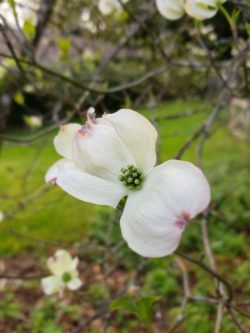
Tree Highlight: Dogwoods
Dogwood trees begin to bloom in April in the Portland area. Many bloom before they leaf out, spotlighting the showy ‘petals’.
Dogwoods (Cornus spp.) are a favorite deciduous garden plant in the Portland area, as seen in the multitude of dogwood species and varieties grown here. The variety of dogwoods boast a wide range of color, bract shape, branching habit, size, and disease resistance.

Dogwood Bracts
The showy ‘petals’ of many dogwoods are not petals at all but modified leaves, called bracts, that surround a cluster of tiny green true flowers in the center.

In the dogwoods with bracts that look like petals, the bracts enclose the inconspicuous flower parts as the bud develops.

As the flower begins to open in the spring, the bracts grow in size.




Once fully open, the previous attachment point can leave an impression on the bract ‘petals’, affecting their shape and marking patterns. This visual feature is a distinctive attribute of many dogwood trees and plays a role in their cultural significance.

Dogwood Growth Habit
There are multi-stemmed dogwood shrubs that grow a foot tall and single-trunked dogwood trees that can be the stunning center of attention of an urban garden at 35 feet tall.


Dogwood Leaves
Leaf color can be variegated, but is usually green in the summer, turning purple or orange-red in the fall.

Dogwood Fruit
The fruits can be small, smooth and deep red, or large, lumpy and strawberry red, depending on the variety. The fruit of many dogwoods are toxic to people.
Noteworthy Dogwood Trees
Dozens of varieties of two non-native dogwoods are grown widely in urban gardens in the Portland area.

The Kousa dogwood (Cornus kousa) has characteristic pointed creamy white bracts, delicate branches, and is more resistant to dogwood anthracnose, a common dogwood fungal disease. It can be grown as a multi-stemmed shrub or trained to grow as a small tree. The Kousa dogwood blooms appear after the leaves, which is later in the season than the other dogwoods.

The Eastern dogwood (Cornus florida) has white, pink, or nearly red blooms. These trees are taller than the Kousa dogwood, and bloom earlier in spring, before leaves appear. The Eastern dogwood is more susceptible to dogwood anthracnose. Avoiding bark injury, encouraging air circulation with proper plant siting and pruning, and ensuring adequate root zone watering without bark or leaf wetting may reduce the likelihood of this fungal disease. There are many varieties of dogwoods available in which the Eastern dogwood has been bred with the Kousa dogwood to produce more disease resistant hybrids.

The Pacific dogwood (Cornus nuttallii) is a northwest native forest understory tree known for its bright white bracts that seem to glow against the backdrop of a shaded forest in spring. The white bracts of the Pacific dogwood are rounded or slightly pointed and up to three inches long. The tree is conical in shape, growing to 40 feet tall, with decorative red fruit clusters and sometimes red leaves in the fall. It grows best in well-drained acidic soil in part shade. Planting site requirements for this stunning tree are very strict, due to the Pacific dogwood’s susceptibility to sunburn as well as dogwood anthracnose. Some cultivars have been created in which the Pacific dogwood is crossed with Kousa dogwood to create more disease resistant trees. Because the Pacific dogwood is difficult to grow in urban gardens, seeing it in its natural habitat is a noteworthy highlight of a forested spring hike.


